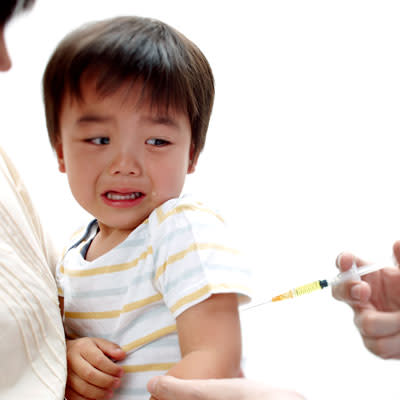8 ways to make shots easier for kids

By Ashlee Davis
Vaccines protect children from dangerous germs. Still, that's little comfort when it's time to get the jab. The good news is that there are ways to ease the pain-or fear of pain, which is the bigger problem.
"In reality, shots don't 'hurt' that much," says Herschel Lessin, MD, pediatrician at the Children's Medical Group in Poughkeepsie, NY. "It's the suffering brought on by the phobia of needles that bring on the pain."
Here are some surprisingly simple strategies that can make your doctor's visit smooth sailing.
Provide distraction
This time-tested parental trick for getting children to behave can help reduce the pain of vaccinations too. Even the slightest diversions can eliminate problems, according to Dr. Lessin.
Successful distractions include playing with a new toy, pointing out a picture on the wall, reciting ABCs, telling your child something funny, or blowing bubbles.
Cough it out
One technique that works for older kids is "the cough trick."
A 2010 study in the journal Pediatrics showed that coughing once before and once during routine vaccinations helped reduce painful reactions among children ages 4 and 5 as well as ages 11 and 12.
Dr. Lessin also tells kids over 3 to imagine it's their birthday and that they're blowing out candles on a cake.
"It works every time," he says. "Or, I'll ask them to blow on a pinwheel."
Health.com: 12 vaccines your child needs
Sweeten it up
A 2010 analysis published in the Archives of Disease in Childhood studied the effect of giving babies 1 to 12 months old a small amount of a sweet solution-sucrose or glucose-before immunization.
In 13 of the 14 study trials, babies given the solution cried less during and after getting the shot compared with babies who received either water or nothing.
"There's no downside to bringing a sugar solution with you to a vaccination," says Dr. Lessin.
Health.com: Sugar before shots helps kids cope
Turn on cartoons
What could be more mesmerizing than playful cartoon characters cavorting across a screen?
A University of Georgia study published in the Journal of Pediatric Psychology showed that children were often less distressed when nurses turned on cartoons during immunizations. "Any distraction technique, whether it be cartoons, videogames, or another focal point, will make the experience smoother," says Dr. Lessin.
If your doctor doesn't have a TV in the examination room, ask if it's okay to bring your own portable DVD player.
Health.com: HPV vaccine effective in men
Use skin-numbing products
EMLA cream, a topical anesthetic, may reduce immunization pain in children. A 2003 study found that babies who received EMLA cream in addition to a sugary solution experienced less pain from their shots.
The cream blocks nerves from transmitting painful impulses to the brain. "(EMLA cream) works well, if you can find it over the counter," says Dr. Lessin. "And you should purchase cream so that you can apply an hour before the vaccination."
Fluori-Methane spray, which cools the skin, could also numb the area and reduce pain, according to a 2004 study.
Stay cool
Be straightforward about why your child needs to get a shot-but, more importantly, be determined. "Kids don't care that it's good for them, so prepping them will only turn the trip into a bigger deal," says Dr. Lessin. "Parents need to realize it's not the child's choice." There's no reason to escalate the situation.
The best thing parents can do is listen to the doctor and take control of the situation. Parents and doctors can work as a team to keep children calm and get the job done.
Health.com: Secrets to a stress-free family
Offer a pacifier
Whether you call it a binkie, paci, or chew chew, a pacifier can help comfort babies getting a shot (if they are used to sucking on one).
A University of Michigan study found that pacifiers can reduce infants' pain before, during, and after vaccinations. And dipping the pacifier in a sugar solution may be even more effective. "Pacifiers or any devices used as counterstimulation, competition with the shot sensation, can be effective," says Dr. Lessin.
After the procedure, breast-feeding may also help reduce the amount of time spent crying by a baby.
Health.com: Immunizations for preemies
Consider the order of the shots
It sounds too good to be true, but something as simple as the order in which shots are given can make a difference.
In a 2009 study, babies were less likely to cry if they were given the combination vaccine for diphtheria, polio, tetanus, pertussis, and Haemophilus influenzae type b (DPTaP-Hib, or Pentacel) followed by the pneumococcal conjugate vaccine (PCV, or Prevnar).
Children who received injections in this order proved to experience less pain compared to those who were given shots in the reverse order.
